Brief summary difference between overmolding and 2k molding
While injection overmolding and 2K injection molding (also known as 2-shot injection moulding) share many similarities, they also have some key differences. See below for the difference between those two moulding processes.
Injection overmolding involves the use of a standard single-nozzle injection machine to combine two distinct types of materials into a single solid product. The overmolding manufacturing process means moving the first part (substrate part) or metal inserts to the subsequent mould (over mold) to create the final product. You can use this technology to add a soft-touch grip to a tool handle or to create a product with multiple colors or textures.
2K injection molding, also referred to as multi-shot injection molding, 2-shot injection molding, or dual-injection molding, involves using a specialized 2K injection machine to simultaneously inject two or three materials (colors) into the same mold. In fact, the 2K injection machine actually has two installed moulds. Unlike overmolding, the 2K moulding machine simultaneously injects both materials, fully bonding them together once the moulding process is complete. The 2k molding process, while complex, is characterized by its speed, efficiency, and high quality.
Compared to both manufacturing technologies, 2K injection tooling offers superior quality and production efficiency. However, due to the high cost of the 2K injection moulding machine, overmolding sometimes serves as a substitute. On the other hand, the cost of an over-molded part is higher than that of a 2K injection-moulded part. However, for low volumes of 2-color moulding parts, injection overmolding can utilize any standard injection-moulding machine to produce the overmoulded parts.
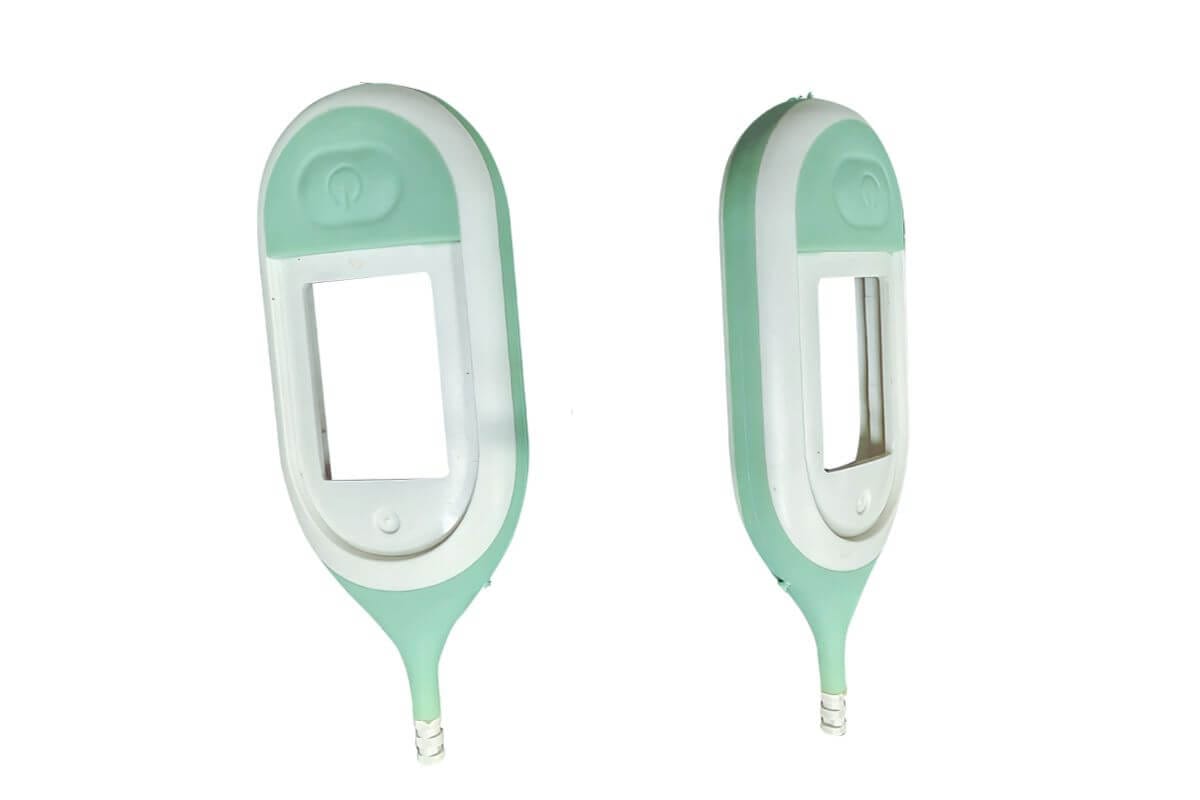
When designing multi-material or two-colored plastic parts, it’s crucial to choose the right moulding process based on your part’s design and production needs. Both overmolding and 2K injection molding have their own advantages and disadvantages. Some of the injection moulded prodcuts can only be created with the overmolding process, while some of the injection-molded parts can only be made with the 2K injection molding process; this is depending on the plastic part geometry design.
If both moulding processes can produce the plastic parts, the 2K molding process will be the most effective for high-volume production.
Both overmolding and 2K injection moulding can be used to create products with multiple materials or layers, but the key difference is that in overmolding, two materials are formed separately (preloading the substrate to the second mould), while in 2K injection molding, two materials are formed together in the same process (of course, a specialized machine is needed).
What is overmolding (over mold)?
Overmolding, or over mold is a manufacturing process that involves molding one plastic over another material to be merged to create a single end product. In plastic overmolding, two separate moulds are required: the substrate, which is the first tool, and the overmould, which is the second mould. Typically, the second mould is made of thermoplastic elastomer (TPE) material, but this is not always the case. If the substrate is machined metal or brass components, then we normally call this insert molding, and insert moulding only needs one mould (over mould) to finish the manufacturing process.
The materials most commonly used for plastic overmolding are thermoplastic elastomer (TPE), rubber, or the same material as the substrate but in different colors. Today, we will primarily focus on the overmolding technology that utilizes TPE materials, which are widely used in various industries. The rigid substrates can be made of a wide range of materials, including polyethylene (PE), polypropylene (PP), polycarbonate (PC), nylon (PA6 or PA66), acrylonitrile butadiene styrene (ABS), polymethylmethacrylate (PMMA), polystyrene (PS), high-impact polystyrene (HIPS), polyphenylene oxide (PPO), acrylonitrile butadiene styrene (ABS), or any other special-purpose material that can be used as substrates.
Overmolding utilizes the injection moulding process to inject one plastic material (Over-mold) over another material (substrate). The overmolding plastic material normally uses TPE, rubber, TPU, or the same material but in different colors. Overmoulded materials will make a strong bond with their substrates, ensuring long-term durability and optimal performance in their intended environments. The use of overmolding removes the need for adhesives when connecting thermoplastic elastomers (TPEs) to hard substrates. The overmolding technique simplifies the molding manufacturing process, lowers costs, and allows for more design flexibility.
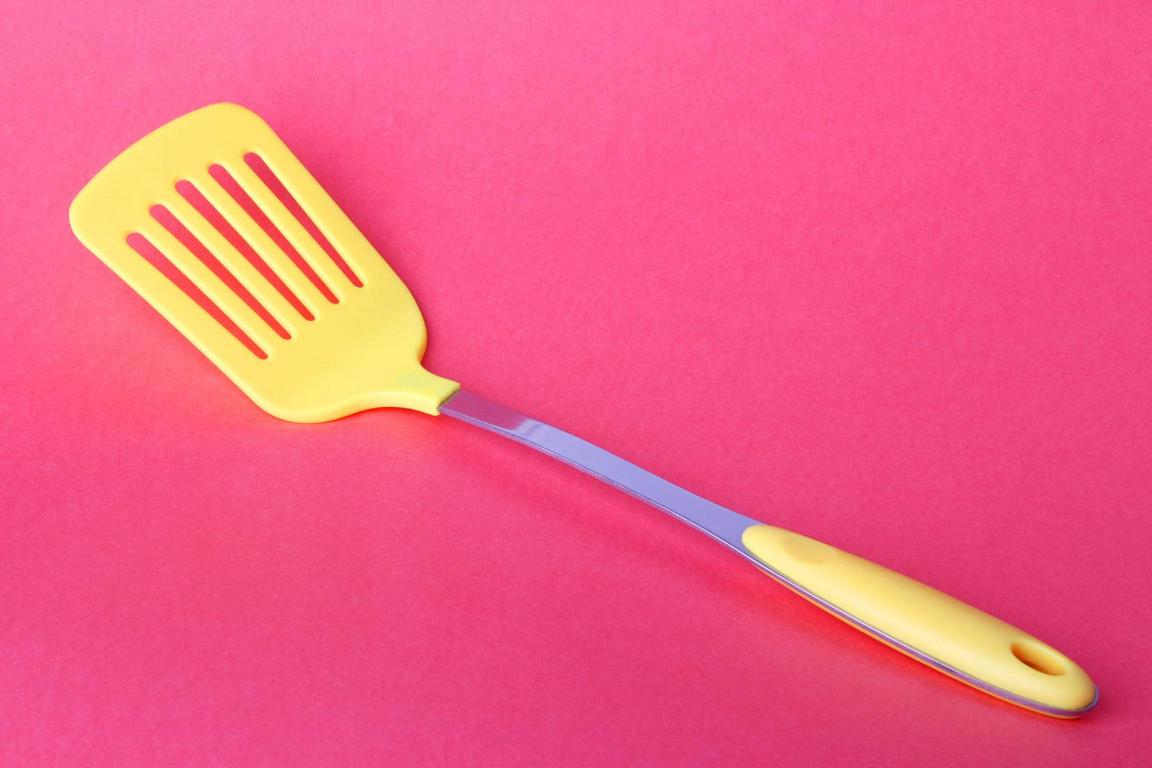
The types of overmolding
Types of overmolding include two-shot sequential overmolding, insert moulding, and multi-shot injection molding (2K and 3K injection moulding, or more).
Two-shot sequential overmolding
In two-shot sequential plastic injection overmoulding, the molding machine injects the first plastic resin into the first mold cavity (substrate mould); after the material cools and forms the first plastic shape, it then opens the tool. All of those molding processes are the same as the traditional injection moulding process.
Once the first substrates are completely finished and cooled, insert the substrate into the second mold (overmold), close the tool, and then inject the second material. The process is also the same as the traditional molding process; the difference is preloading the substrate into the cavity before the manufacturing process begins.
All of those moulding processes will be done with traditional injection machines.
Inert overmolding
Insert over-molding uses pre-formed inserts or metal inserts placed into the mold before injecting the second material; if the inserts are metal or brass, then we call it metal insert molding. This overmolding process, which we used a lot, for example, metal screw insert moulding and filter insert molding, this type of over-molding uses a traditional injection moulding machine to proceed, which puts the metal inserts into the mold cavity during the single injection molding cycle.
Like the below picture is showing, the insert overmolding with metal inert. This type of overmoulding only requires one injection mold; however, if the first insert is made of a plastic part, we will need an additional mold for the first plastic insert part.
Multi-shot injection moulding or 2k injection molding
Multi-shot injection molding, sometimes called 2-shot injection moulding, is also a type of overmolding. This molding technology requires specialized injection moulding machines, which have two injection units. The injection barrels can be parallel or perpendicular to each other. There will be two injection moulds assembled in this machine; one injection tool makes the substrate, and the other one is for the overmolding process.
The moulding machine injects the first plastic resin into the first cavity, also known as the substrate mould. Once the material cools and forms the first plastic shape, it opens the tool. This process is identical to the traditional injection manufacturing process. Once the moulds are open, the movable half rotates 180° without ejecting the substrate. Next, it closes the molds and initiates the second injection, also known as the overmold.
Simultaneously, it injects the first shot. Once the second cavity completes its molding process, it opens the tools again and ejects the overmoulded product from the overmold. During this process, a new substrate is generated for the second cycle.
This is a completely molding cycle for the 2k injection moulding process.
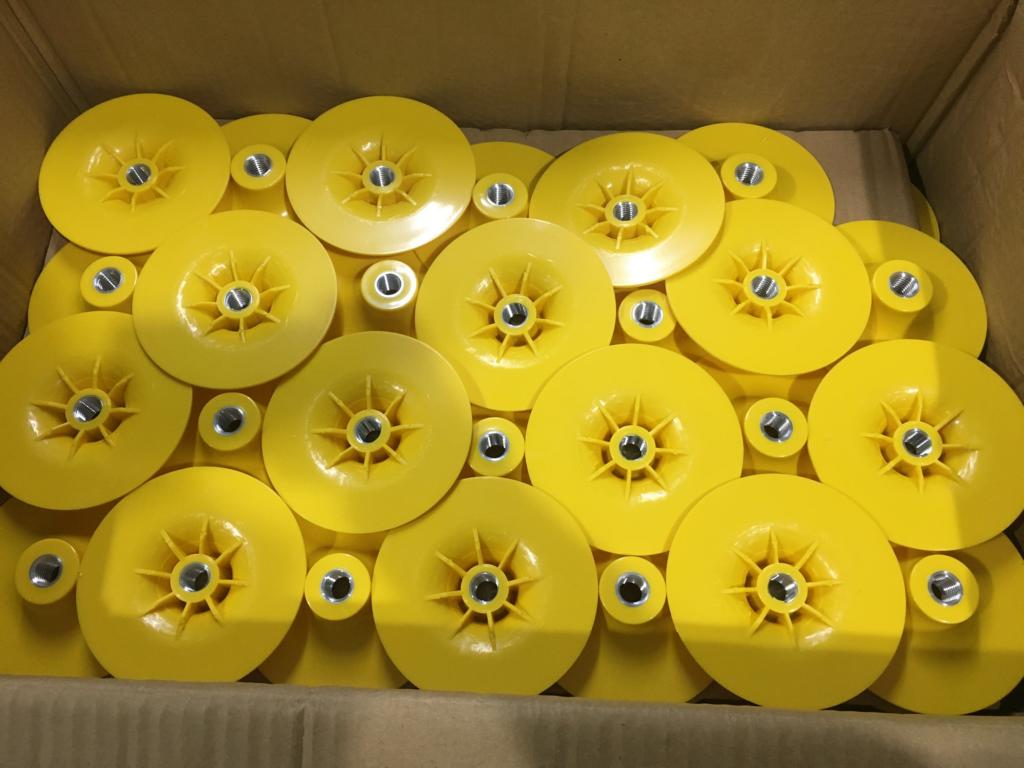
TPE overmoulding
TPE (thermoplastic elastomer) plastic materials are used a lot in the injection molding field, especially for the overmolded parts. In the overmolding market, over 80% of overmolded parts are made by TPE over molding,
TPE Over molding is the injection moulding process where TPE (thermoplastic elastomer) is formed onto a rigid material (for example, PC, PA66, or ABS material) according to the specific requirement. The overmolded TPE will strongly bond with the first plastic and maintain its final use purpose. To prevent the TPE material from stripping off from the second material, material selection and part design are very important.
A TPE overmolding manufacturer will consider all relevant factors when selecting the optimal moulding manufacturing method for a plastic injection molding part, choosing between 2K molding and the overmolding process. Critical factors include production capacity, material selection, available equipment, and labor costs.
Normally, the overmolding process is the most popular choice when total production volumes are less than 50K. This number is only a reference and not a definitive one because it depends on the size and complexity of the part design. For higher volume production requirements (total volume over 200,000 units), a 2-shot injection moulding process will be a better option; of course, this is still dependent on the part design because some parts can only be made with an overmoulding process; for example, the below part can only be created with the overmolding process.
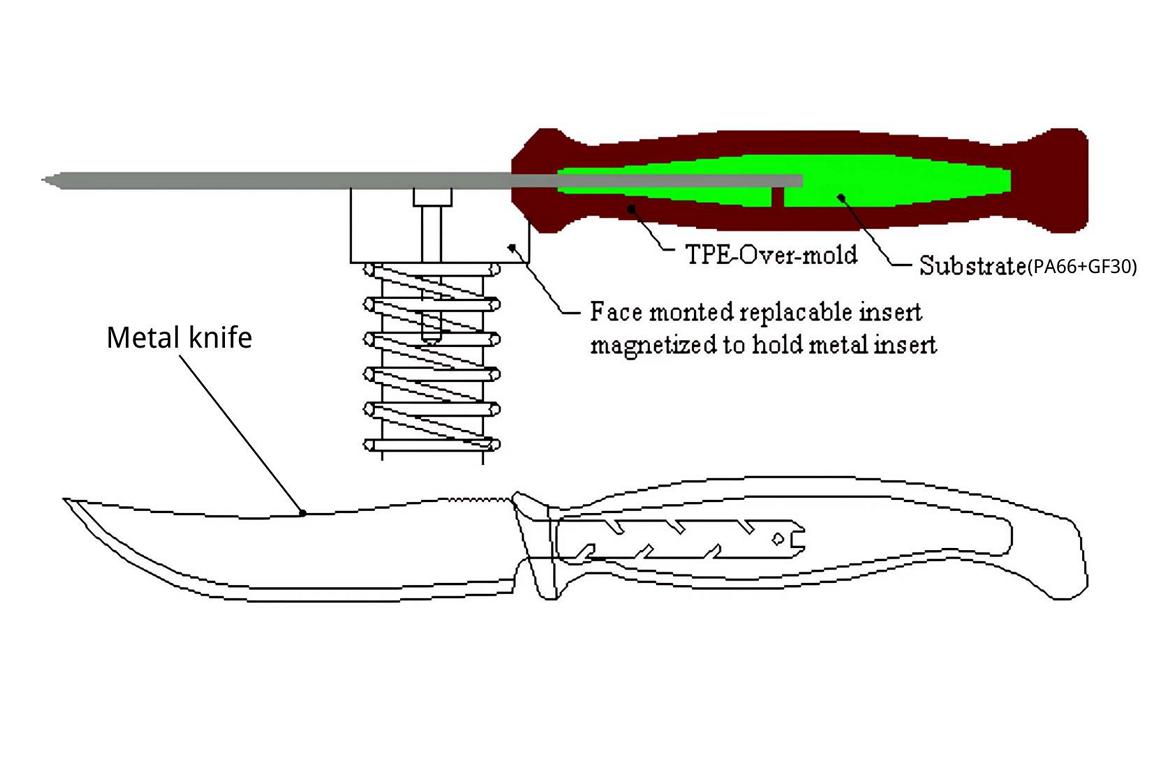
In every TPE overmoulding or 2K injection molding process, the number one issue is to achieve maximum adhesion between the TPE and the substrate. Some TPE overmoulding may have significantly different bond strengths between multi-shot and overmolding. Even if an excellent bond is produced with two-shot molding, the same material may have a low bond strength when using overmolding. Thus, to make high-quality finished overmolding and 2K moulding products, a thorough understanding of TPEs, part design, engineering plastics, and the specifics of the moulding process is important.
TPE Overmolding materials seletion tips
As we know to make high quality TPE overmolded product, both TPE and substrate materials are most important, the number one factor to define the quality of overmoulded part is how good the mergeration between two matreials, if the TPE is easy to strip off from the substrate then the material will be issues, below there are some tips for meterials selestion, following thsi tips you will find the best suitable material for overmoulded part.
Thickness of TPE overmolded part
Designers frequently request the softest TPE. They don’t realize that a TPE’s soft durometer doesn’t provide much to “cushion” below a particular thickness (usually less than 0.1mm). Thinner TPE overmoulded part feel harder—the hardness impact depends on thickness. Multiple closely spaced ribs can produce the illusion of thickness without utilizing much material. Many kitchen utensil handle use this method.
Hardness of TPE plastic material,
There is a softness of TPE material that you need to select when you make TPE overmolding, especially TPE thickless, which is more than 0.5 mm. To have a good touch feel, you may need to test different types of TPE shore A material, unless special function requirements, normally we use in the market will range from TPE Shore A 40 to 60; if too little, that may eash to strip off from the substrate; if hardness is too high, the touch feel may not be good enough.
Substrate material selection tips
Compared to TPE material, substrate materials will be easier to choose; most materials can be substrates, including nylon/PA (PA66 or PA66 GF30, PA6 or PA6 GF30 plastic), Polycarbonate (PC), Acrylonitrile Butadiene Styrene (ABS, PC/ABS, Acetal (POM), PMMA, and so on. The final substrate material selection is dependent on the final purpose. If you are uncertain about the optimal material for your TPE overmolded parts, please reach out to us and we will provide you with some recommendations.
Surface finish on substrate and TPE overmold
Surface finish on the substrate will also affect the adhesion of TPE rubber. The stronger the adhesion, the less likely it will strip off, normally will be good polishing between merge surface between TPE and substrate, on the TPE cavity side, soemtime surface finish will effect to the TPE overmold as well, sometime higi polishing to the TPE cavity mold, the TPE overmolding part will stick to cavity side, add some small VDI texture will improve this.

TPE overmolding part design tips
Part design, as previously mentioned, plays a crucial role in creating a high-quality TPE overmolding product. Generally, the design of the substrate part is similar to that of other plastic injection tooling parts. For further details, please refer to the page on plastic part design for injection molding. But there are some factors on the merge area between the substrate and TPE overmoled area; there is no standard design for this area since different parts have different geometries, but there are some key points that you need to think about when you do the overmoled part design. Those factors will be:
How to seal the TPE overmolding well and provent from flash When you do the overmoling part design:
TPE material easily exhibits flash (0.03 mm gap), and bondable TPE materials meet more stringent criteria than standard TPE polymers. The same holds true when designing parts. Unlike traditional part design, two-component part designs must account for shrinkage from two different thermoplastic materials. Both substrate and over-moulding have their own gate and runner systems, which must be tailored to the individual material properties used.
To meet the best cycle time, substrate and overmolding wall thickness should be consistent. In most over-molding applications, 1-3 mm wall thickness ensures satisfactory bonding. Thicker pieces should be cored out to reduce shrinkage, weight, and cycle time. To avoid backfills and gas traps, wall thickness transitions should be gradual. Add radius to the sharp coners to reduce stress issues. Avoid deep, unavailable blind pockets or ribs. Long draws should have a 3-5 degree draft angle for easy demoulding. In overmolded compounds, deep undercuts can be designed if an advancing core is used when the mold opens, the part has no sharp corners, and the elastomer bends during ejection.

Most TPE compounds have significant flow direction tool shrinkage and moderate cross-flow shrinkage. After ejection from the tool, the over-moulding compound may contract more than the substrate. This can stretch the substrate, usually in the overmolding material’s direction. This is especially true for long, thin parts or components with a low-modulus substrate or one thinner than the over mold. Use higher-modulus substrate materials and stiffening ribs to mitigate this. Thinner coatings and lower-hardness over-mould grades assist. Relocating the gate to affect TPE flow may also help.
If you can enhance the design to ensure a tighter bond between the TPE material and the substrate, such as by increasing the cross-sectional area, without compromising its functionality or appearance, it would be beneficial. Below is one of exmple of overmolding part design tips.
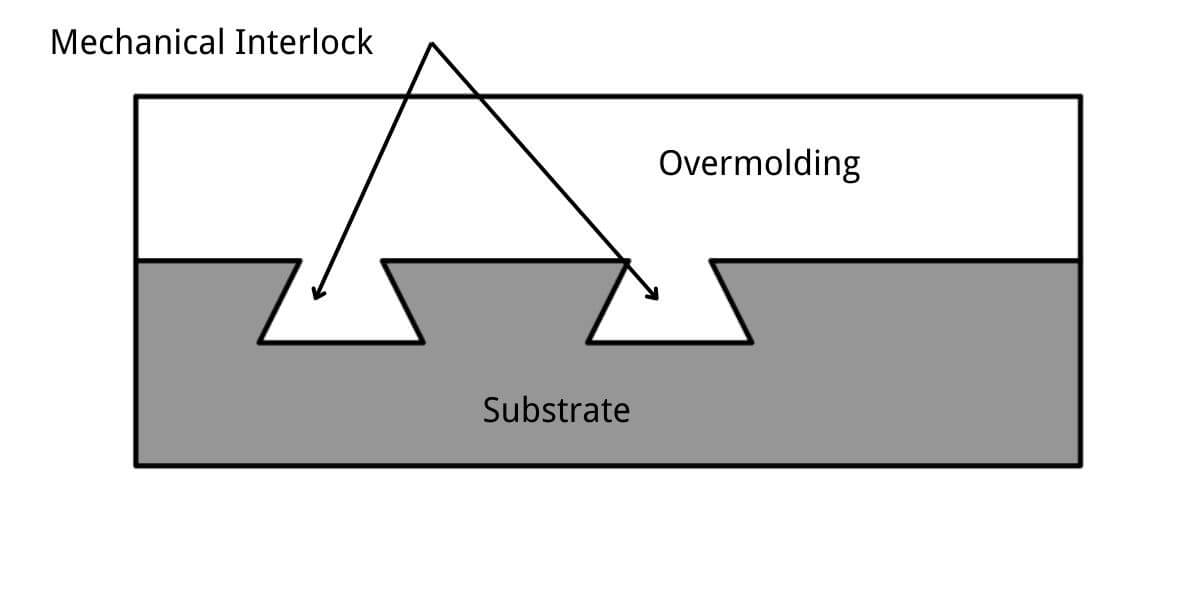
Avoid designing too many separated areas on the TPE overmolding part, as this can complicate the overmold manufacturing and moulding process. Especially many areas are designed to the parting line area; this will be hard to solve the flash completely when you design the TPE overmoulded part, designing as simple as possible, unless some function purpose.
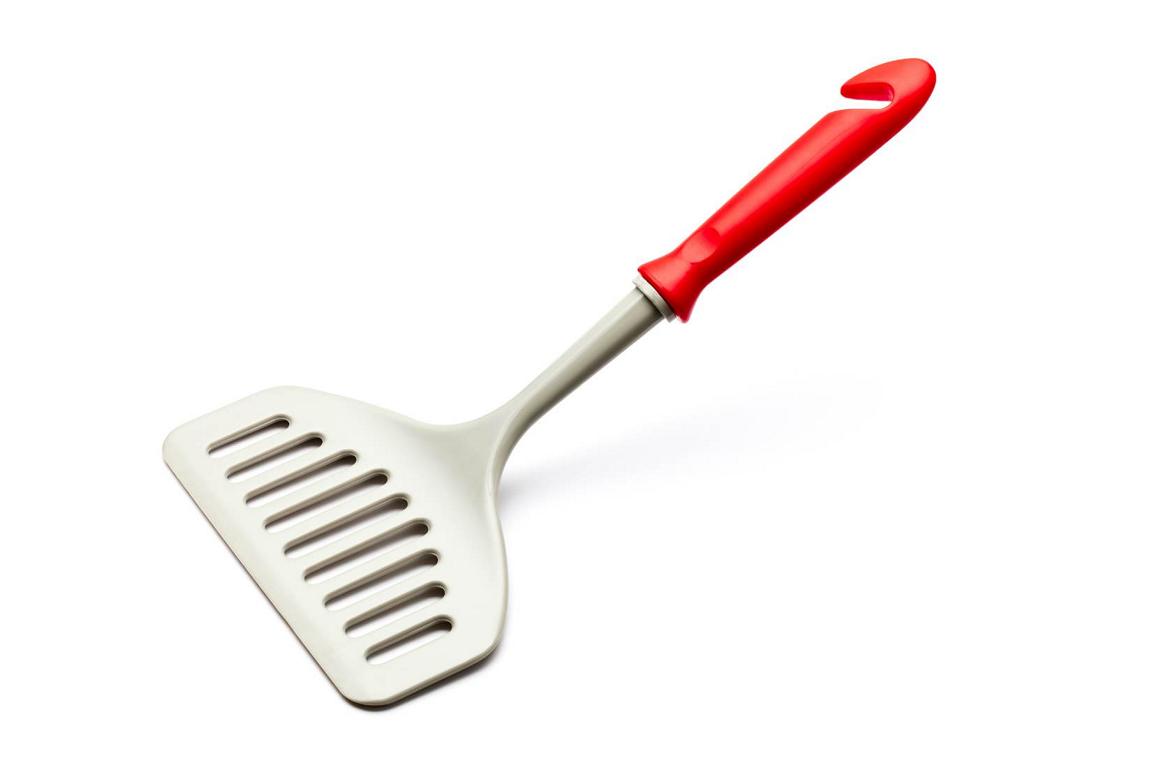
Tips for overmold desgin:
When we design injection mold for overmolding parts, the first mold (substrate tool) we will add shrinage rate according to plastic shrinakge rate, but for the over mould (second tool), we will not add any shinakge rate on the injection over mold.
Overmolding cost
The base cost of an overmolding is not a fixed number that will be the same for every application. It has a varying value that can fall between 1 and 10 dollars.
This is an extremely wide price bracket. The right value changes based on several components involved in the overmolding process. These factors that influence the cost are:
Injection molding Equipment
The upfront cost of equipment for injection moulding can change greatly depending on its application and type.
There is little-scale injection moulding equipment that businesses keep in house. Then there are big overmolding machines generally used by service providers and those in the big-scale manufacturing industry with large production volumes.
Professional industrial overmolding equipment costs between $50,000 and $200,000. There may be shipping costs involved. These machines are not for amateurs and hobbyists, as they need skilled operators.
Overmold manufacturing costs
While the overmolding equipment is a one-time investment, creating the over mold according to each custom design is an additional cost, and each single product design will require a unique over mould. It is an expense for every different part produced. over mold manufacturing costs are one of the most vital cost factors for overmoulded parts.
This over mold cost can vary depending on the part design, part size, and quality required to create the moulds. Generally, three factors are employed for this objective, which are listed below:?
Design complexity
Highly complex designs that requires complex overmold, this often include features like multiple cavities, intricate geometries, sliders, and lifters. These elements require advanced engineering, extended development time, and additional manufacturing cost, all of which increase overmolding tooling costs.
Part size
Over mold is the same as other injection moulds; a large size will require a large mouldbase and moulding machine, which will increase the over mold cost and unit moulded part cost.
Labor costs
Over mold is normaly hard than normal mold, because it needs perfect mold fitting, specailly is TPE overmolded on the substrate, TPE is very easy to go flash, the skilled technicians are needed to monitor machines, perform quality checks, and mold fitting operations, which adds to labor costs,
Since the the overmolding typically involves manual or robotic pre-loading the substrates into the cavity, the molding cost will be much higher than traditional molding cost.
Waste cost
Material waste from sprues, runners, and rejected parts adds to costs. Overmolding will have more reject costs than traditional costs; if one part is rejected, that means the substrate is wasted as well. Employing hot runner systems can minimize waste by eliminating runners, but these systems come with higher initial investment costs.
Final summarize for the overmoulding cost
If you are looking for over-molded parts for your custom injection moulding parts, then you do not need to pay any cost on the injection molding equipment, because your supplier should have this, but you need to pay for the over mold cost, over-moulding process cost, materials cost, packing cost, and so on. If you want to know the price of your overmolding project, please contact us and we will quote you in 24 hours.
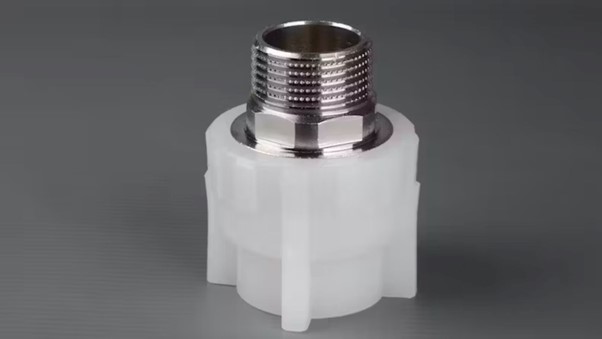
Metal insert moulding
How to reduce overmolding cost
Overmolding is the preferred manufacturing process due to its cost-effectiveness and reliability.
While the process is affordable compared to its alternatives, you can further decrease the costs. For that objective, here are some points that you need to take into account:
Optimizing the CAD design
A single part can be approached via different CAD designs. Anyway, not every design idea is perfect. Some designs for the same part may lead to time and resource waste. So, simplifying part complexity via efficient CAD design ensures optimal utilization of resources.
Reducing part size
Bigger parts are not always excellent parts. When the size of the parts rises, so does the expense of the injection molds needed for the parts. If the same process can be accomplished by decreasing the part size, it is a good idea to opt for it.
Resuing over molds
Make full use of the over molds by reusing them for many applications. You cannot just use the same mold for the same part but also for similar parts as well, when you design similiar part you can even use interchangeable cavity and core to save the tooling cost.
Using DFM (Design for Manufacturing) Analysis
DFM stands for design for manufacturing. DFM in overmolding refers to producing a part that serves the objective of the customer and is within their stipulated budget.
A thorough DFM analysis helps align the design with manufacturing capabilities, for examle, ensure the design meets functional requirements without unnecessary complexity, and use lower-cost thermoplastic elastomers (TPEs) compatible with the substrate. which can lower down costs. Go to design for manufacturing page to know more.
Reduce Cycle Times as Much as Possible
There is a direct correlation between reducing cycle times and improving operational efficiency and costs:
Optimised Cooling Channels: better cooling linee design in the mold can reduce the amount of time needed for cooling and increase the quality of the part, this is same to traditional mold.
Decrease the amount of material waste
Efficiency in the use of materials is a primary factor in cost reduction, for high volume products requrirement, use hot runners in order to reduce the amount of scrap material resulted from sprues and runners.
Incorporating regrind material while ensuring that its percentage does not damage the quality of the item is an important step in the recycling process.
Make sure perfect mold fitting can reduce the waste as well, use stable injection molding machine can reduce the waste cost.
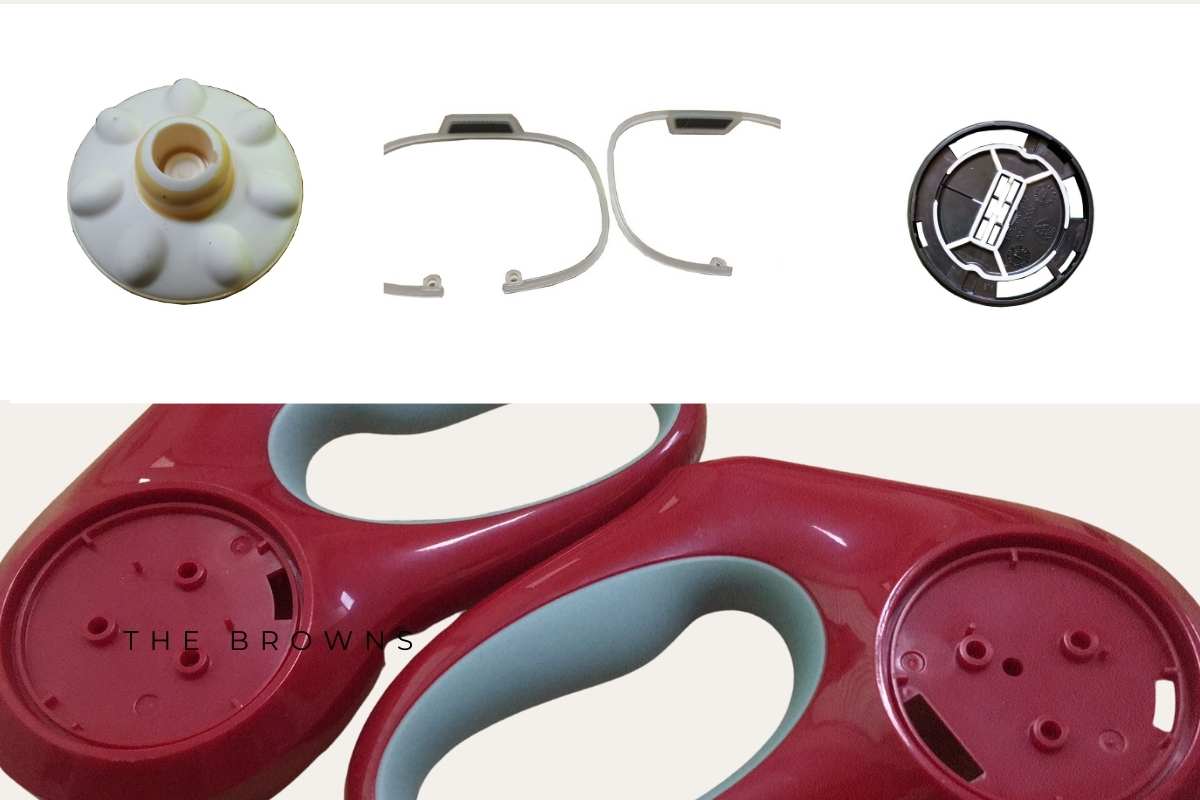
Both over-molding and 2k injection molding are very similar processes, sometime both moulding processes can work on the same part, but something can only be created with single overmolding or 2K injection molding, this is completely depending on the part design.
Advantages of injection overmolding
- Compared to 2K injection molding, over-molding is easier to make. You can use a normal injection machine to make two or three different colors in one molded part or two or three different materials in one end part.
- For some small quantities of two-color molding part projects, you do not need to invert or hire a 2K injection molding machine; using the overmoulded process is the best and most cost-effective way to meet customer requirements.
- It increases the design diversity and also exalts the end product in many material compositions.
- With reduced assembly costs, there are fewer secondary activities or processes carried out on the end products. This reduces the cost of labor. Also, after manufacture, no more costs are incurred.
- The parts have a high level of stability and constitution since, after being left to mechanically interlock, they become one.
- Products overmolded using plastic have high resistance to vibration and shock due to the plastic resins having been structured perfectly.
- The plastic moulded parts are more reliable because there is no bonding at the production stage.
- The end items are of the desired standard, such as eye-catching designs and firm components.
Disadvantage of injection over moulding
- Since the over moulding process involves moving the first substrate part to another over mold, the tolerance is not as good as in the 2K injection molding process.
- The production capacity is not as efficient as 2K injection molding, as it requires robots or manual labor to insert the substrate into the overmoulded tool. This will take time, and the molding parameter is sometimes not stable, especially when two or more substrates are in one tool. This will lead to additional problems and a higher waste rate, resulting in twice the amount of waste (from the substrate and overmolded material).
- With the overmolding process, there are fewer available choices in terms of plastic compatibility. Some materials may not bond well together or may not be able to withstand the high temperatures and pressures of the injection molding process.
- There are no secondary practices carried out on the end products of over-moulding. When the plastic material becomes cold, activities and adjustments come to a complete halt.
- In cases where products are scarce, it is expensive to run such an operation. Sincerely, you need someone to put the substrate into over-mold, so the cycle time and production cost are increased accordingly.
- The overmolding process normally requires two molds, one for substrate and one for over mold, so the initial tooling cost will be higher.
- Overmolding is a more complex process than traditional injection molding, requiring precise coordination between the two injection systems and a proper mold design.
- If there is an issue with the overmolding process, troubleshooting and fixing problems with overmolding can be more difficult than with traditional injection molding.
What is 2k injection molding? (Two-shot moulding)
Two-shot injection molding, or 2K injection molding, is a manufacturing process used to create two colors or materials into one plastic. This two-shot molding technology blends two materials or two different material colors into one plastic part by using a 2K injection moulding machine.
The chemical bonding process involved in this process is very important because it is capable of combining two or more materials into one part. When using the 2K injection molding technology process, material selection will be an important factor in the success of the project or not.
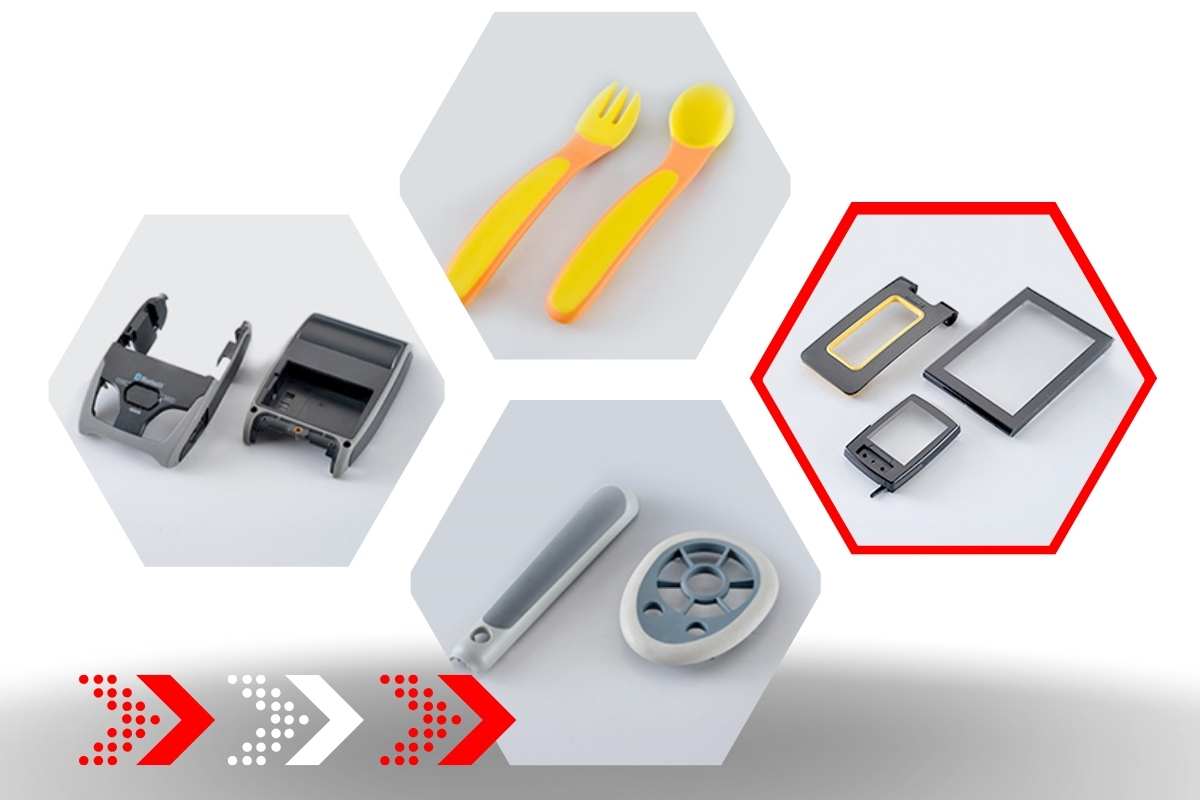
Benefits of 2K injection molding
2K injection moulding provides a number of benefits over traditional one-material injection molding. Some of these benefits contain:
Cost-effective
The 2K injection molding process combines two compatible materials in a single machine cycle. It begins with the first material being injected into the primary mold. The moving half then rotates 360 degree, and close to eject the plastics for the second material to be overmolded in the secondary cavity. in the maintime the first injection is working synchronous.
The use of adhesives or further assembly is not necessary for this seamless technique, which guarantees the high quality bonding between the materials.
Because the method uses only one cycle instead of separate machine cycles, it costs less for any production run and needs fewer employees to make the end product while delivering more items per run. It also ensures a powerful bond between the materials without the need for additional assembly down the line.
Improved efficiency
Two-shot molding permits multiple components to be created with one tool, decreasing the amount of labor required to run your parts and eliminating the need to join or weld components after the molding process.
Better quality
Two-shot is carried out within one tool, permitting lower tolerances than overmolding processes, a high level of accuracy and repeatability, and reduced scrap rates.
Solve the part design issues
Two-shot molding permits the creation of complex mold designs that incorporate different materials for functionality that cannot be achieved via after-molding processes.
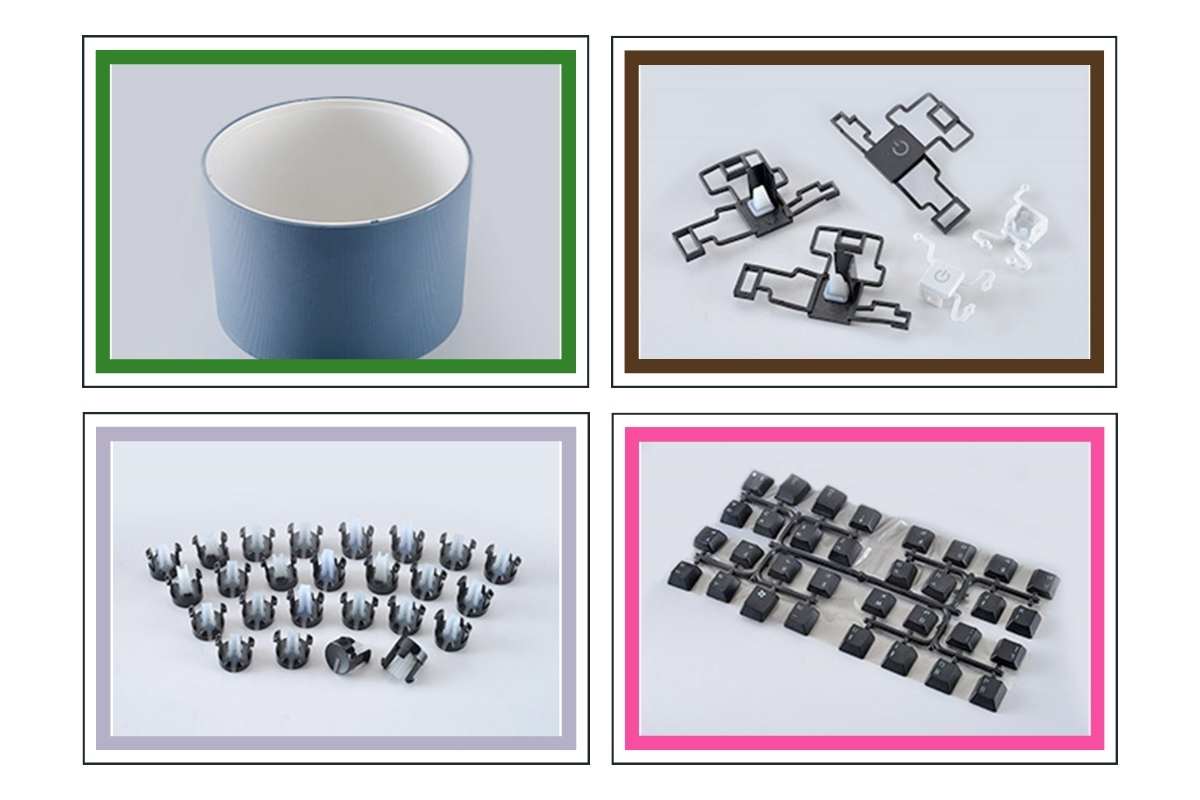
Disadvantages of 2K injection moulding
2K injection molding has many advantages, but like everything, it has its pros and cons.
A disadvantage of 2K injection molding is that the mould costs are higher than traditional injection mold. because 2K injection tooling requires two molds, the first shot and the second shot (that is why we call it two-shot molding), and making 2K injection molds are more difficult than making two separate traditional molds because those two moulds will run together in the same machine (a two-shot injection moulding machine). so it needs two moulds to switch over without any problem.
Additionally, the 2K injection molding process must use a 2K injection machine, which also makes the machine more costly and requires a special technical operator to adjust the machine. This is also a higher cost than traditional injection tooling. Ultimately, we recover the 2K injection molding costs by reducing labor and assembly costs, as the manual application of, for example, a seal is no longer necessary. This eliminates an assembly step.
Another disadvantage of 2K injection molding is that it makes the recycling of plastic items difficult because often two different plastics are gathered. Even when the plastics are “from the same family,” the quality of return flows will be very low, which makes it hard to reuse the plastic for a high-standard application.
How to choose overmolding and 2K injection molding services
You may have questions about when you need to use over moulding and when you should use the 2K injection molding process. Here are some simple suggestions:
- If the quantity of the overmolding or 2K molding part is only a few thousand or ten thousand, it is recommended to use the overmolding process instead of 2k moulding process as it can significantly reduce mold costs.
- If you require more than 500,000 parts, 2K injection molding is the most cost-effective manufacturing process. This is due to the high labor costs associated with overmolding and the high initial cost associated with 2K moulds, two-shot injection moulding machines, and related equipment.
- Overmolding is the only method available for some parts, while the double injection molding process is required for others. This depends on the part design structure. If you’re unsure, send your data to info@plasticmold.net. We can check this for you and provide a price for your reference.
Looking for over moulding or 2k injection molding service?
Sincere Tech is one of the best injection molding companies in China. If you are looking for overmolding, insert moulding, 2K molding, or any other custom molds, send us your 3D design drawing and your requirements; we will never share your data with anyone else. We are willing to sign an NDA document to ensure the safety of your project.
We will offer you the most competitive price for high-quality overmoulded parts, 2K tooling and moulding, plastic tooling, and plastic parts for the long-term business relationship, and we will suggest the best injection manufacturing process for your products.
More than 18 years of experience providing plastic mold making and custom mold services in overmolding, 2K moulding, die casting, machining, and so on, plus 18 years of fluent technical English communication (technical English communication is very important to work with worldwide customers).
Small orders are accepted. Main export markets: Asia, Australia, Central and South America, Eastern Europe, North America, Western Europe, and the worldwide.

